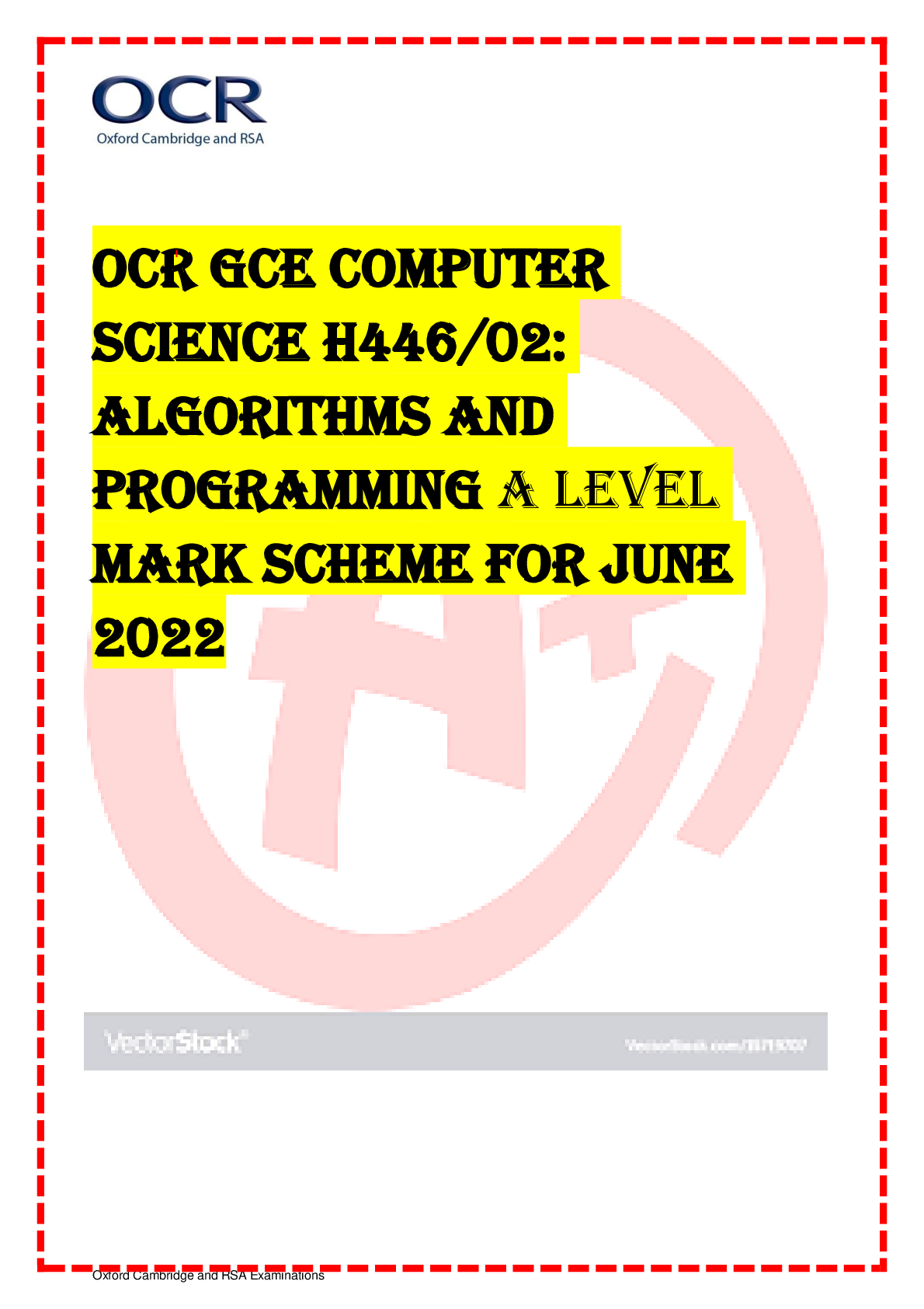English > AS Mark Scheme > GCE English Language and Literature (EMC) H474/01: Exploring non-fiction and spoken texts Advanced G (All)
GCE English Language and Literature (EMC) H474/01: Exploring non-fiction and spoken texts Advanced GCE Mark Scheme for Autumn 2021
Document Content and Description Below
Oxford Cambridge and RSA Examinations GCE English Language and Literature (EMC) H474/01: Exploring non-fiction and spoken texts Advanced GCE Mark Scheme for Autumn 2021Oxford Cambridge and RSA Ex... aminations OCR (Oxford Cambridge and RSA) is a leading UK awarding body, providing a wide range of qualifications to meet the needs of candidates of all ages and abilities. OCR qualifications include AS/A Levels, Diplomas, GCSEs, Cambridge Nationals, Cambridge Technicals, Functional Skills, Key Skills, Entry Level qualifications, NVQs and vocational qualifications in areas such as IT, business, languages, teaching/training, administration and secretarial skills. It is also responsible for developing new specifications to meet national requirements and the needs of students and teachers. OCR is a not-for-profit organisation; any surplus made is invested back into the establishment to help towards the development of qualifications and support, which keep pace with the changing needs of today’s society. This mark scheme is published as an aid to teachers and students, to indicate the requirements of the examination. It shows the basis on which marks were awarded by examiners. It does not indicate the details of the discussions which took place at an examiners’ meeting before marking commenced. All examiners are instructed that alternative correct answers and unexpected approaches in candidates’ scripts must be given marks that fairly reflect the relevant knowledge and skills demonstrated. Mark schemes should be read in conjunction with the published question papers and the report on the examination. © OCR 2021H474/01 Mark Scheme October 2021 2 1. Annotations Annotation Meaning Blank Page – this annotation must be used on all blank pages within an answer booklet (structured or unstructured) and on each page of an additional object where there is no candidate response. Positive Recognition Assessment Objective 1 Assessment Objective 2 Assessment Objective 3 Assessment Objective 4 Assessment Objective 5 Attempted or insecure Analysis Detailed Effect Expression Link Answering the question View Relevant but broad, general or implicitH474/01 Mark Scheme October 2021 3 Subject-specific marking instructions Candidates answer Question 1. Assessment objectives AO1, AO2, AO3 and AO4 are assessed in this question. The question-specific notes on the task provide an indication of what candidates are likely to cover in terms of AOs 1, 2, 3 and 4. The level descriptors are organised with the dominant assessment objective first; for this question, AO4 followed by AO1, AO3 and AO2. The notes are neither prescriptive nor exhaustive: candidates should be rewarded for any relevant response which appropriately addresses the Assessment Objectives. INTRODUCTION Your first task as an Examiner is to become thoroughly familiar with the material on which the examination depends. This material includes: • the specification, especially the assessment objectives • the question paper and its rubrics • the texts which candidates have studied • the mark scheme. You should ensure that you have copies of these materials. You should ensure also that you are familiar with the administrative procedures related to the marking process. These are set out in the OCR booklet Instructions for Examiners. Please ask for help or guidance whenever you need it. Your first point of contact is your Team Leader. Awarding Marks (i) There is one question worth 32 marks. (ii) Award a single overall mark out of 32, following this procedure: • refer to the question-specific Guidance for descriptions of Higher and Lower response and indicative content • using ‘best fit’, make a holistic judgement to locate the answer in the appropriate level descriptorH474/01 Mark Scheme October 2021 4 • place the answer precisely within the level and determine the appropriate mark out of 32 considering the relevant AOs • bear in mind the weighting of the AOs, and place the answer within the level and award the appropriate mark out of 32 • there should be clear evidence of candidates’ response to AO4, AO1, AO3 and AO2. If a candidate does not address one of the assessment objectives they cannot achieve all of the marks in the given level. Mark positively. Use the lowest mark in the level only if the answer is borderline / doubtful. Use the full range of marks, particularly at the top and bottom ends of the mark range. These are the Assessment Objectives for the English Language and Literature specification as a whole. AO1 Apply concepts and methods from integrated linguistic and literary study as appropriate, using associated terminology and coherent written expression. AO2 Analyse ways in which meanings are shaped in texts. AO3 Demonstrate understanding of the significance and influence of contexts in which texts are produced and received. AO4 Explore connections across texts informed by linguistic and literary concepts and methods. AO5 Demonstrate expertise and creativity in the use of English to communicate in different ways. WEIGHTING OF ASSESSMENT OBJECTIVES The relationship between the units and the assessment objectives of the scheme of assessment is shown in the following table: USING THE MARK SCHEME Study this Mark Scheme carefully. The Mark Scheme is an integral part of the process that begins with the setting of the question paper and ends with the awarding of grades. Question Papers and Mark Schemes are developed in association with each other so that issues of differentiation and positive achievement can be addressed from the very start. This Mark Scheme is a working document; it is not exhaustive; it does not provide ‘correct’ answers. The Mark Scheme can only provide ‘best guesses’ about how the question will work out, and it is subject to revision after we have looked at a wide range of scripts. The Examiners’ Standardisation Meeting will ensure that the Mark Scheme covers the range of candidates’ responses to the questions, and that all Examiners understand and apply the Mark Scheme in the same way. The Mark Scheme will be discussed and amended at the meeting, and administrative procedures will be confirmed. Co-ordination scripts will be issued at the meeting to exemplify aspects of candidates’ responses and achievements; the co-ordination scripts then become part of this Mark Scheme. Before the Standardisation Meeting, you shouldH474/01 Mark Scheme October 2021 5 read and mark in pencil a number of scripts, in order to gain an impression of the range of responses and achievement that may be expected. In your marking, you will encounter valid responses which are not covered by the Mark Scheme: these responses must be credited. You will encounter answers which fall outside the ‘target range’ of Bands for the paper which you are marking. Please mark these answers according to the marking criteria. Please read carefully all the scripts in your allocation and make every effort to look positively for achievement throughout the ability range. Always be prepared to use the full range of marks. The weightings for the assessment objectives are: AO4 5% AO1 4% AO3 4% AO2 3% Total 16% The dominant assessment objective is AO4 Explore connections across texts informed by linguistic and literary concepts and methods. Answers will also be assessed for AO1, AO3 and AO2. Answers should explore connections across the texts, considering similarities and differences, informed by linguistic concepts and methods (AO4). They should develop a coherent argument, using relevant concepts and methods from linguistic and literary study and associated terminology (AO1). Answers should be developed with reference to contextual factors (AO3) and explore the ways speakers and writers shape meanings (AO2). The criteria below are organised to reflect the order of the dominant assessment objectives. A response that does not address any one of the four assessment objectives targeted cannot achieve all of the marks in the given level. Level 6: 32–27 marks AO4 Excellent and detailed exploration of connections across texts informed by linguistic and literary concepts and methods.H474/01 Mark Scheme October 2021 6 AO1 Excellent application of relevant concepts and methods from integrated linguistic and literary study as appropriate. Consistently coherent and fluent written expression and apt and consistent use of terminology relevant to the task and texts. AO3 Perceptive understanding of the significance and influence of the contexts in which texts are produced and received. AO2 Excellent, fully developed and detailed critical analysis of ways in which meanings are shaped in texts. Level 5: 26–22 marks AO4 Clearly developed exploration of connections across texts informed by linguistic and literary concepts and methods. AO1 Secure application of relevant concepts and methods from integrated linguistic and literary study as appropriate. Consistently clear written expression and appropriate use of terminology relevant to the task and texts. AO3 Clear and relevant understanding of the significance and influence of the contexts in which texts are produced and received. AO2 Clear and well developed critical analysis of ways in which meanings are shaped in texts.H474/01 Mark Scheme October 2021 7 Level 4: 21–17 marks AO4 Competent exploration of connections across texts informed by linguistic and literary concepts and methods. AO1 Competent application of relevant concepts and methods from integrated linguistic and literary study as appropriate. Generally clear written expression and mainly appropriate use of terminology relevant to the task and texts. AO3 Some understanding of the significance and influence of the contexts in which texts are produced and received. AO2 Competent analysis of ways in which meanings are shaped in texts. Level 3: 16–12 marks AO4 Some attempt to explore connections across texts informed by linguistic and literary concepts and methods. AO1 Some application of relevant concepts and methods selected appropriately from integrated linguistic and literary study. Generally clear written expression with occasional inconsistencies and some appropriate use of terminology relevant to the task and texts. AO3 Some awareness of the significance and influence of the contexts in which texts are produced and received. AO2 Some analysis of ways in which meanings are shaped in texts.H474/01 Mark Scheme October 2021 8 Level 2: 11–7 marks AO4 Limited attempt to make connections across texts informed by linguistic and literary concepts and methods. AO1 Limited attempt to apply relevant concepts and methods from integrated linguistic and literary study appropriately. Some inconsistent written expression and limited use of terminology relevant to the task and texts. AO3 Limited awareness of the significance and influence of the context in which texts are produced and received. AO2 Limited analysis of ways in which meanings are shaped in texts. Level 1: 6–1 marks AO4 Very little attempt to make connections across texts informed by linguistic and literary concepts and methods. AO1 Very little attempt to apply relevant concepts and methods from integrated linguistic and literary study appropriately. Inconsistent written expression and little use of terminology relevant to the task and texts. AO3 Very little awareness of the significance and influence of the contexts in which texts are produced and received. AO2 Very little analysis of ways in which meanings are shaped in texts. 0 marks: no response or response not worthy of credit.H474/01 Mark Scheme October 2021 9 Question Response Marks Guidance 1 Text A from the anthology is Alistair Cooke’s obituary for Marilyn Monroe was published in The Guardian, 6 August 1962. The British-American broadcaster and journalist was most famous for his weekly radio essay, ‘Letter from America’. Text B is a transcript of an extract from an episode of the nightly American television chat show Larry King Live. This episode was created in June 2001 to celebrate what would have been the 75th birthday of Marilyn Monroe. Larry King was the host. Carefully read the two texts and compare the ways in which the writer in Text A and the speakers in Text B use language to convey meaning. In your answer you should analyse the impact that the different contexts have on language use, including for example, mode, purpose and audience. A higher level response (Levels 4 –6) will: AO4: Explore explicit comparisons between texts, aware of both similarities (e.g. both texts involving reporting and commemorating Monroe’s life for audiences) and differences (one is completely crafted, planned, whilst the other involves guests speaking spontaneously with a host who has pre-planned questions.) AO1: Use vocabulary and terminology appropriately, referring to a range of language levels including 32 The indicative content shows an integrated approach to the four assessment objectives. AO4, AO1, AO3 and AO2 Context e.g. • Both texts have a different context - one was written for the British broadsheet The Guardian at the time of Monroe’s death and one was produced for an American television chat show in 2001. There is a focus on engaging the audience within both with tales of this celebrity figure. • Purpose: Text A is a broadsheet obituary to report, inform and commemorate Monroe and provide details of her life and her impact on society. It attempts to elevate her and aggrandize her life as well as inform/entertain the readers. Text B follows the conventions of a televised entertainment chat show with a host asking guests questions. It has been created to mark the 75th birthday of Monroe. It shows elements of both scripted speech from the host and spontaneous speech from the guests (both in the studio and the guest in the New York bureau). The host tries build a relationship with the audience and guests. Mode e.g. • Text A features a wide range of linguistic features typical of a crafted, written article such as: cyclical structure that starts and ends with the death, figurative language (metaphors and similes), semantic fields (melodrama, Raymond Chandler, plot), extended themes (outsider). • Text B features both linguistic features typical of spontaneous speech including fronted conjunctions (And), contractions (we’ll), general extenders (or something), interruptions and unfinished utterances,H474/01 Mark Scheme October 2021 10 grammar and discourse e.g. interrogative, imperative, subordinate clauses, distribution of turns, terms of address etc. Express ideas fluently and coherently with a wide vocabulary. AO3: Understand the significance of a range of contextual factors, e.g. the British and American contexts, the impact of on-the-spot questions on a live talk show vs. retrospectively crafted obituary; collaborative, spoken text vs. written obituary; the crafted, scripted dialogue of the host Larry King and the spontaneous, unrehearsed speech of the other studio guests; the typical features and expectations of the broadsheet obituary and television talk-show genres; the focus on or the need to convey the dramatic parts of Monroe’s life to engage the audience and interest an audience who like celebrities/historical figures; the positioning of the writer of the obituary and the position/power of the host over the conversation. AO2: Explore the ways the speakers and writer use language to shape meaning, e.g. interaction between host and their studio panellists vs. more detached tone of article; the portrayal of Monroe as troubled and/or misrepresented; discussion of the objectification of Marilyn Monroe vs. sympathy for her personal experiences.. A lower level response (Levels 1 –3) will: A04: Make general comparisons between how ideas are conveyed e.g. expressing opinions or feelings vs. trying to entertain an audience. changes in pace, false starts, but it also contains elements of scripted dialogue in King’s opening speech. Lexis: e.g. • In both texts we see lexical choices that show enthusiasm and admiration towards Monroe (tremendous, wonderful, vitality, charming, shrewd), often emphasised through triadic structures or listing. • In both texts we also see a negative outlook on Monroe’s life through abstract nouns (depression), or verbs (cursed, prying). This helps to convey the idea that society was partly to blame for Monroe’s death. • Text A: adjectival choices show a juxtaposition (shrewd, pathetic) to covey the idea of how Monroe struggled with her own identity and the identity imposed on her by society. The rhetorical devices help to convey these oppositions with juxtaposing references to Chaplin’s Little Man against liquid-lipped goddess. Such juxtapositions show a more controlled and crafted text reflecting its written mode and broadsheet audience. • Text B: some speakers seem to use a more poetic choice of phrase when speaking about Monroe with some rhetorical devices (like a monologue on a page) that sometimes seem at odds with spoken mode and could suggest it has been rehearsed. Larry King’s opening speech conveys elements of scripted speech such as the use of pronouns to include the audience (tell us) which could address both a studio audience and television viewers. Other speakers reflect the spontaneity and informal nature of the conversation using colloquial, American nouns (gal), with a conversational style, (who I think, you know, any good performer)H474/01 Mark Scheme October 2021 11 A01: Use some appropriate terminology, mainly at level of word choice, e.g. colloquial language choices, use of adjectives, nouns etc. A03: Recognise and convey some understanding of the differences between the ways ideas and opinions are conveyed e.g. spontaneous speech vs. planned. A02: Recognise and convey an understanding of the way some features of language are used to create meaning, e.g. spontaneity and anger shown through repetition and interruptions vs. the crafted metaphors and similes of the obituary. Semantics Both texts are designed to convey the idea that Monroe was a troubled individual and society was partly responsible for this. • In Text A the writer tries to set himself apart from other journalists who have written about Monroe’s early life (to go into details now would be as tasteless as prying...). He suggests that she could not contend with the stereotypes or the exaggerated version of her that was created by the media (the liquid-lipped goddess). He wants to portray that she was a baffled girl, struggling with fame, and haunted by the stereotypes that society had created of her. • The host in Text B wants to present his audience with information about Monroe, yet also wants to explore the darker, perhaps more dramatic parts of her life (did you sense a sense of depression?) and show that she also struggled with fame. The speakers also want to cast blame on others for Monroe’s death (she felt betrayed). One of the speakers also blames society’s distorted perceptions of Monroe that continue even after her death, (blown into something that never existed). His sudden anger could perhaps suggest a closeness between himself and Monroe. • Hyperbole in both to aggrandize and celebrate Monroe, yet also to emphasise the extent of her troubles. Nouns and pronouns • Text A starts with the proper noun and subject (Marilyn Monroe) and continues in the third person to inform and convey the idea of it being factual and informative. Nouns are often pre-modified because of written mode. The writer does not refer to himself but makes implicitH474/01 Mark Scheme October 2021 12 suggestion about his own writing (to go into details now would be as tasteless). However, there is a slight switch when he uses a first person pronoun (we) when referring to society. Nouns are used throughout the obituary (Monroe, Marilyn) to focus on the person who has died, apart from the final paragraph and she is referred to as ‘this orphan’ rather than her name, to emphasise the idea that she could ‘feel no other identity’ she has lost sight of her true self. • In Text B, the host uses first person (us) to try to build a relationship between host and audience - both studio and at home - and the speakers use many personal pronouns (I) to convey their own personal recollections of Monroe. Discourse • Text A: opens with a more factual paragraph, before moving into the kind of opinion piece more associated with a comment article than an obituary. The sequencing of biographical facts is partly chronological, but interwoven with analysis and discussion. • Text B: length and distribution of turns, initiating conversation, the different relative status of the speakers and the host, terms of address show informal relationship such as using first names with some guests whereas other guests receive full names. Sentences • Text A: declarative complex sentence to start. The positioning of the main clause (Marilyn Monroe was found dead) at the very start of the obituary to convey the important news, before the prepositional phrases (in bed). Monroe, as a subject, is often put at the very startH474/01 Mark Scheme October 2021 13 of sentences (she died, she talked) to reflect the informative purpose. Sentences are often complex, often starting with phrases (These stony sentences) to draw readers in. They use several subordinate clauses yet there is a shift to a simple sentence (It is nevertheless true) when the writer wants to emphasise a point. There is also a shift to listing during several parts to emphasise her many qualities and attributes. There are some structures that lower the formality and perhaps is the writer’s attempt to engage with the audience, with the use of fronted conjunctions (So in the end). • Text B: structures are typical of spontaneous speech, sentences often long, starting with conjunctions (And) and sometimes linked with conjunctions (but), some sentences are incomplete as is the nature of spontaneous speech and the host trying to move the show along or keep to a certain time, several speakers uses listing to emphasise all Monroe’s qualities. The host starts sentences with imperatives to convey the power he has over the conversation (Tell us about), and also speaks using interrogatives. Tense • Text A: predominantly past tense to express the past life of Monroe. Does try to use a list of verb infinitives (to pout, to wisecrack, to love a stranger) which almost makes the reader forget that she is dead, or could convey the idea that the memories of these actions still live on. Text B: the host opens using contracted modals (We’ll) to describe what is coming up on the show for the audience, but also uses past modals (would have been the 75th birthday) to perhaps also convey an element of sadness linked to the subject matter. Past tense verbs are oftenH474/01 Mark Scheme October 2021 14 used by the speakers when referring to Monroe (she talked), yet when referring to friends’ actions the tense changes (talking) to convey the idea that stories and rumours about Monroe still live on. Mr Curtis reinforces this idea by using the progressive form (he’s talking) to show his annoyance at how people continue to make up false stories even after her death, and he reinforces his anger with the use of dynamic verbs (writing) to stress their actions. His present perfect tense (they’ve taken this woman) conveys this is still happening and is continuous.OCR (Oxford Cambridge and RSA Examinations) The Triangle Building Shaftesbury Road Cambridge CB2 8EA [Show More]
Last updated: 1 year ago
Preview 1 out of 16 pages
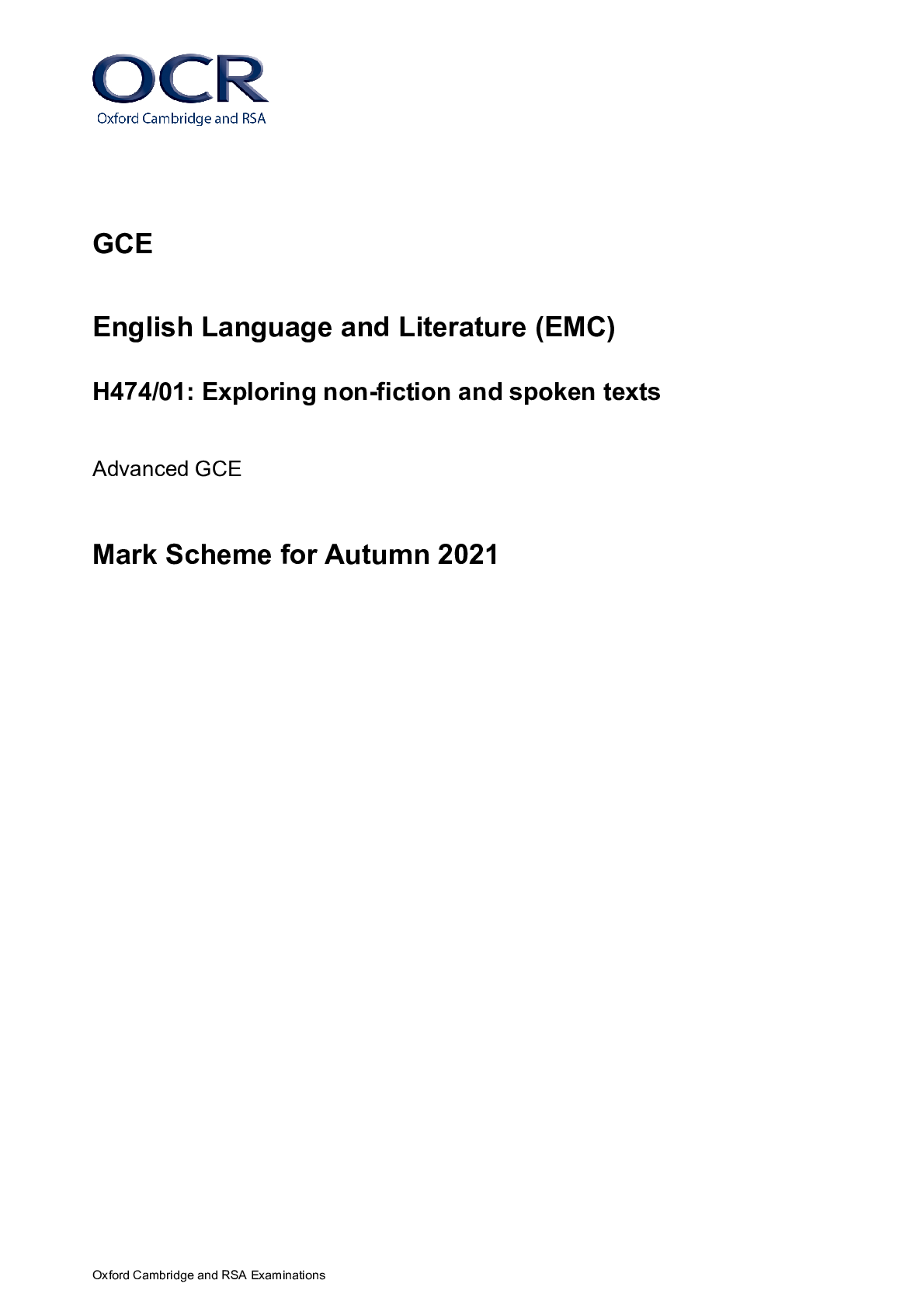
Reviews( 0 )
Document information
Connected school, study & course
About the document
Uploaded On
Oct 10, 2022
Number of pages
16
Written in
Additional information
This document has been written for:
Uploaded
Oct 10, 2022
Downloads
0
Views
67








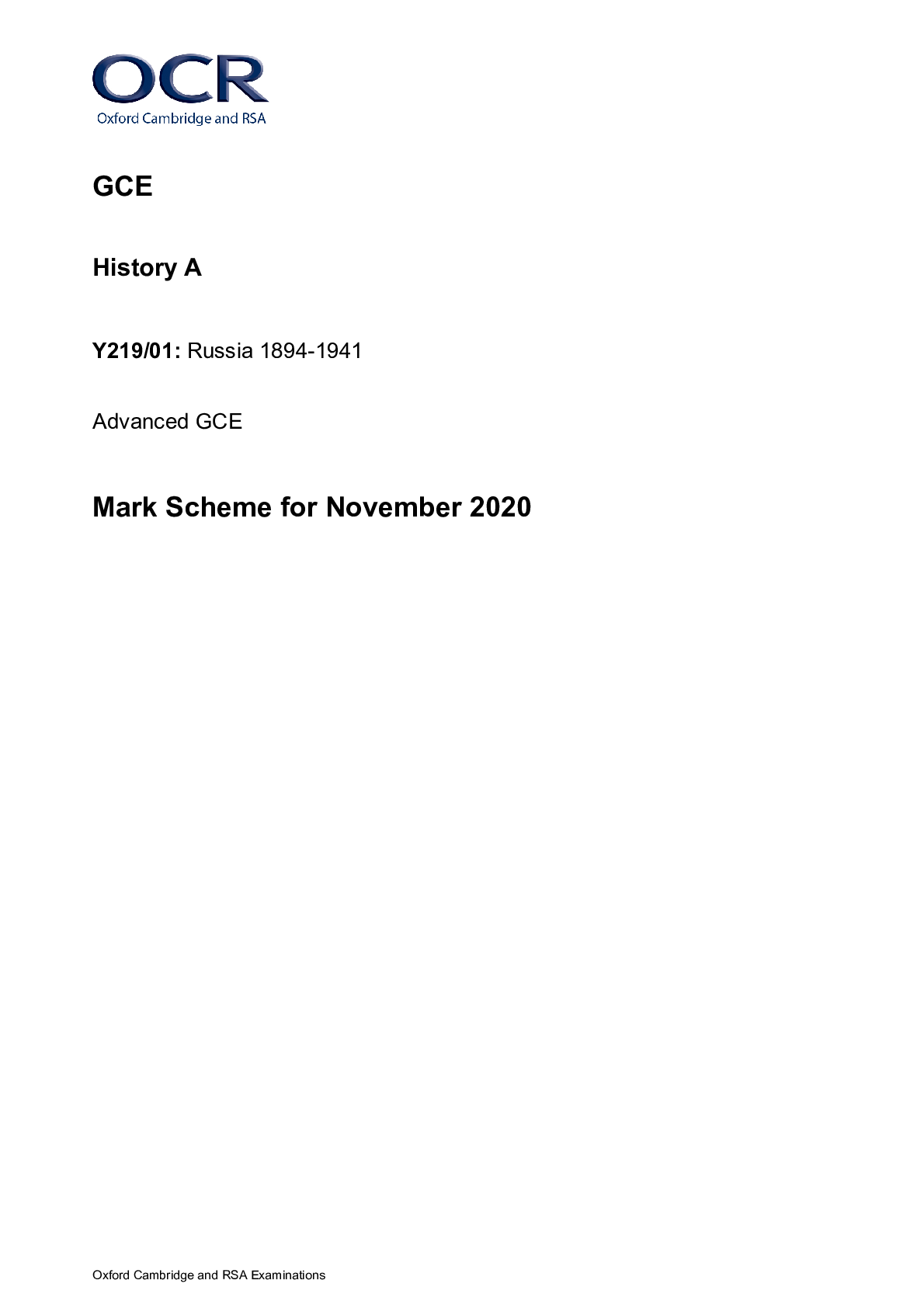
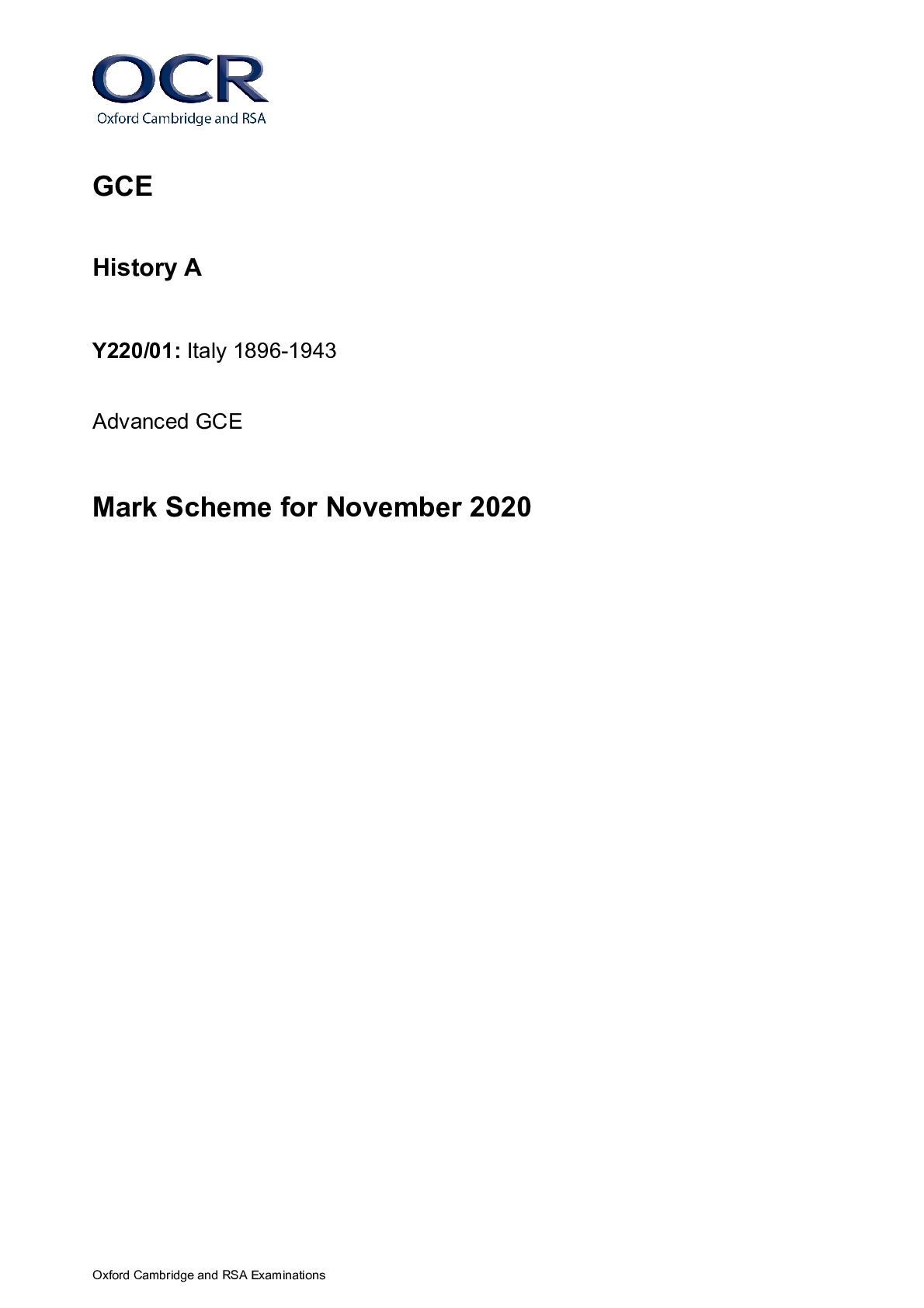

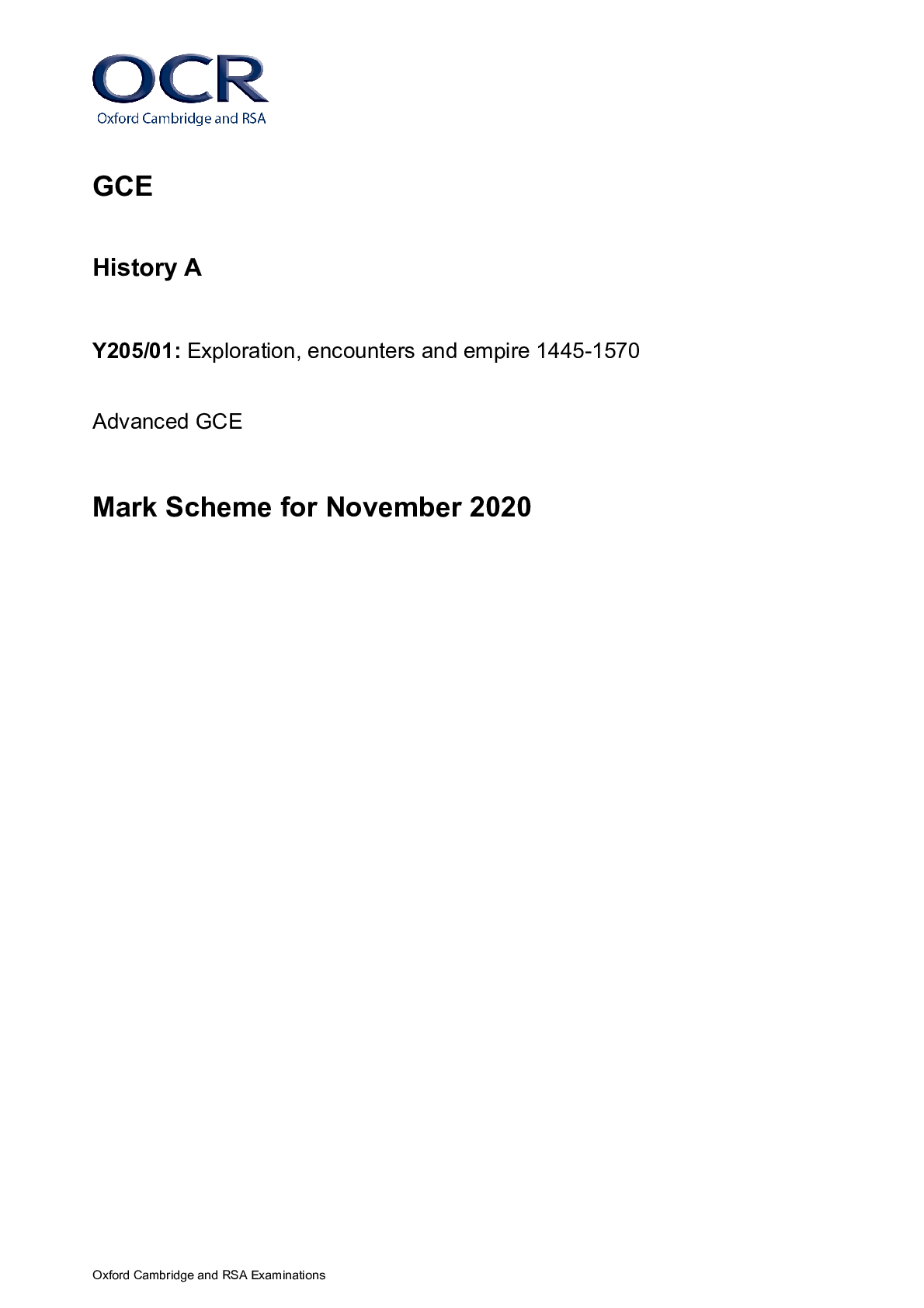
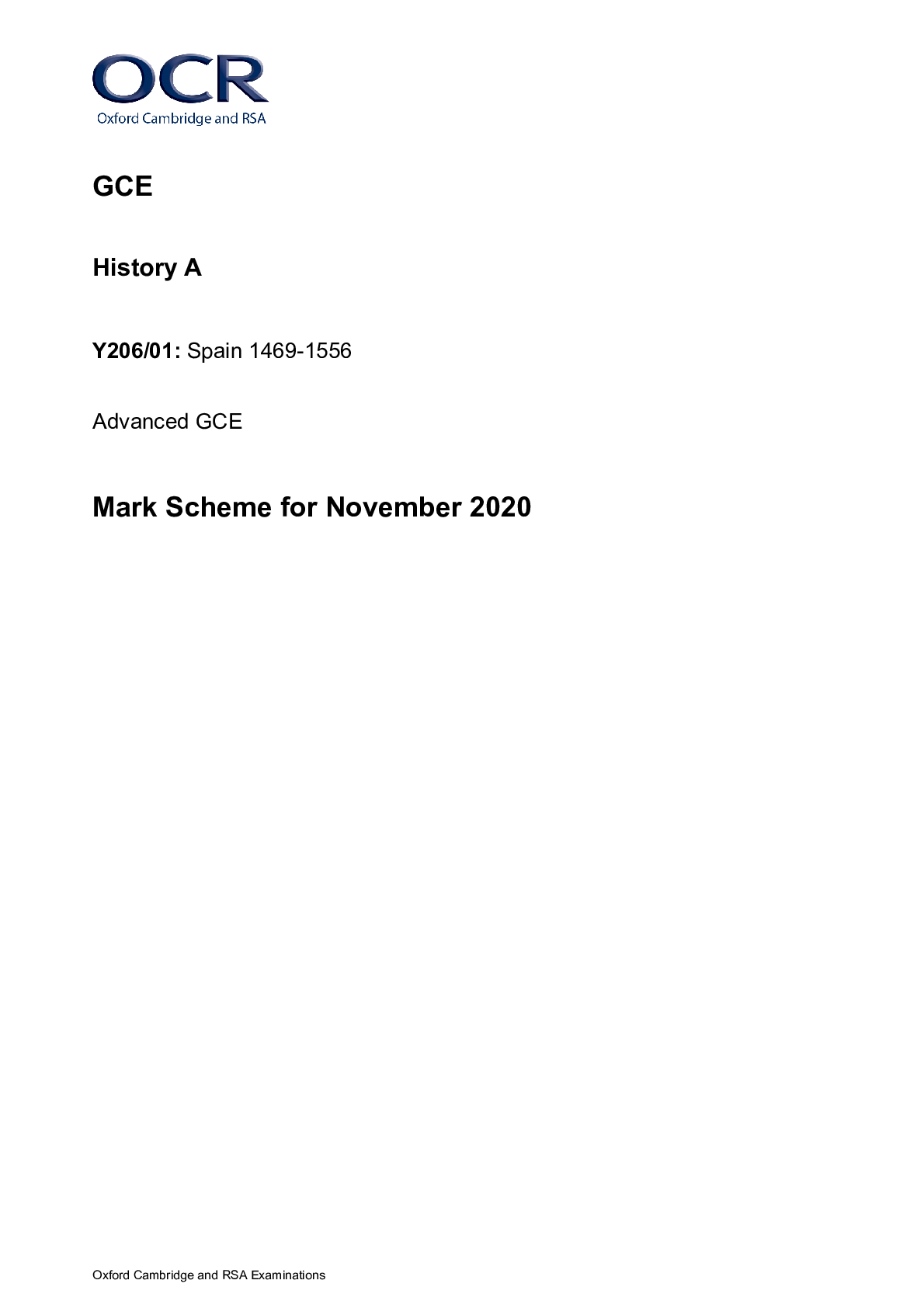
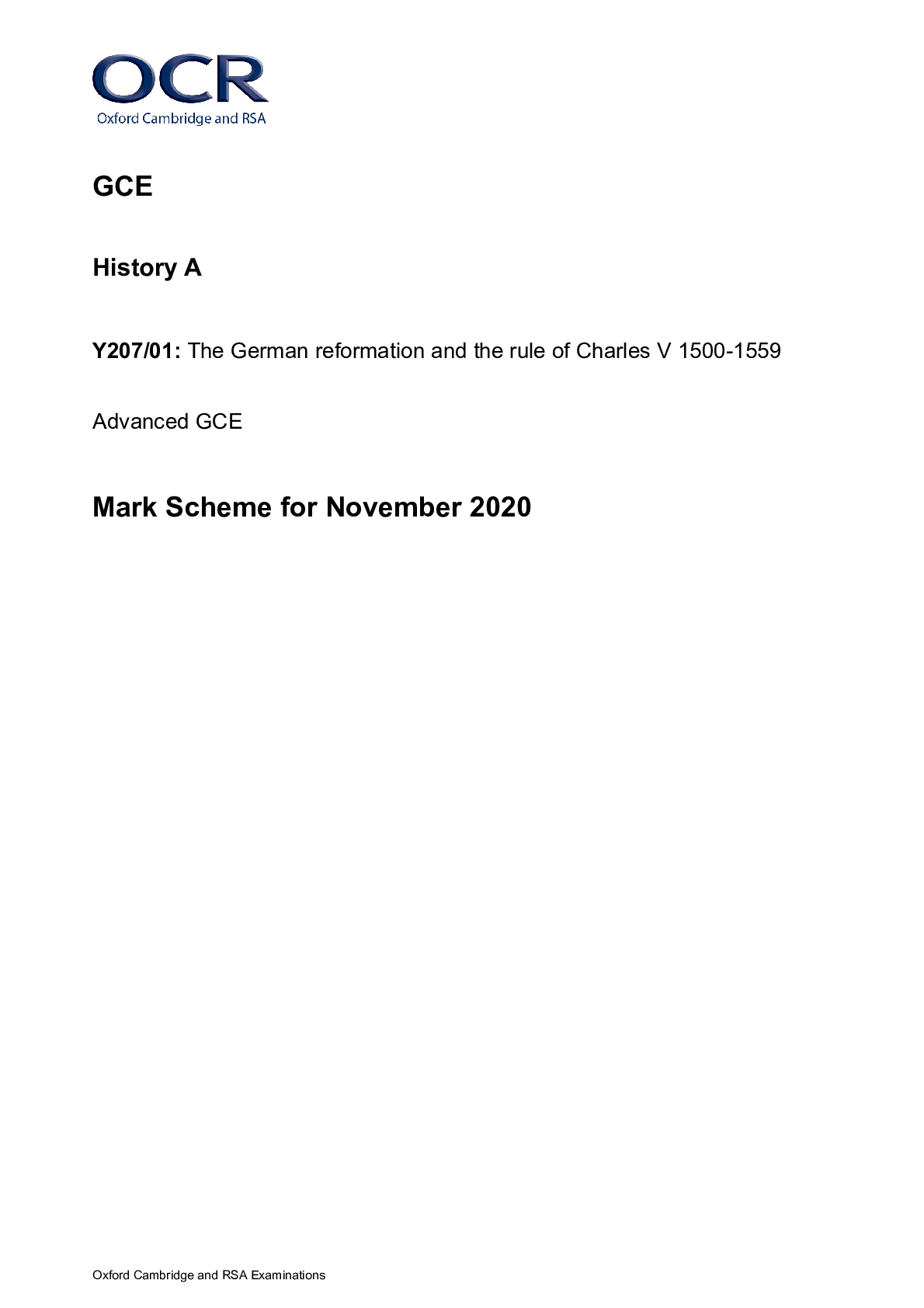
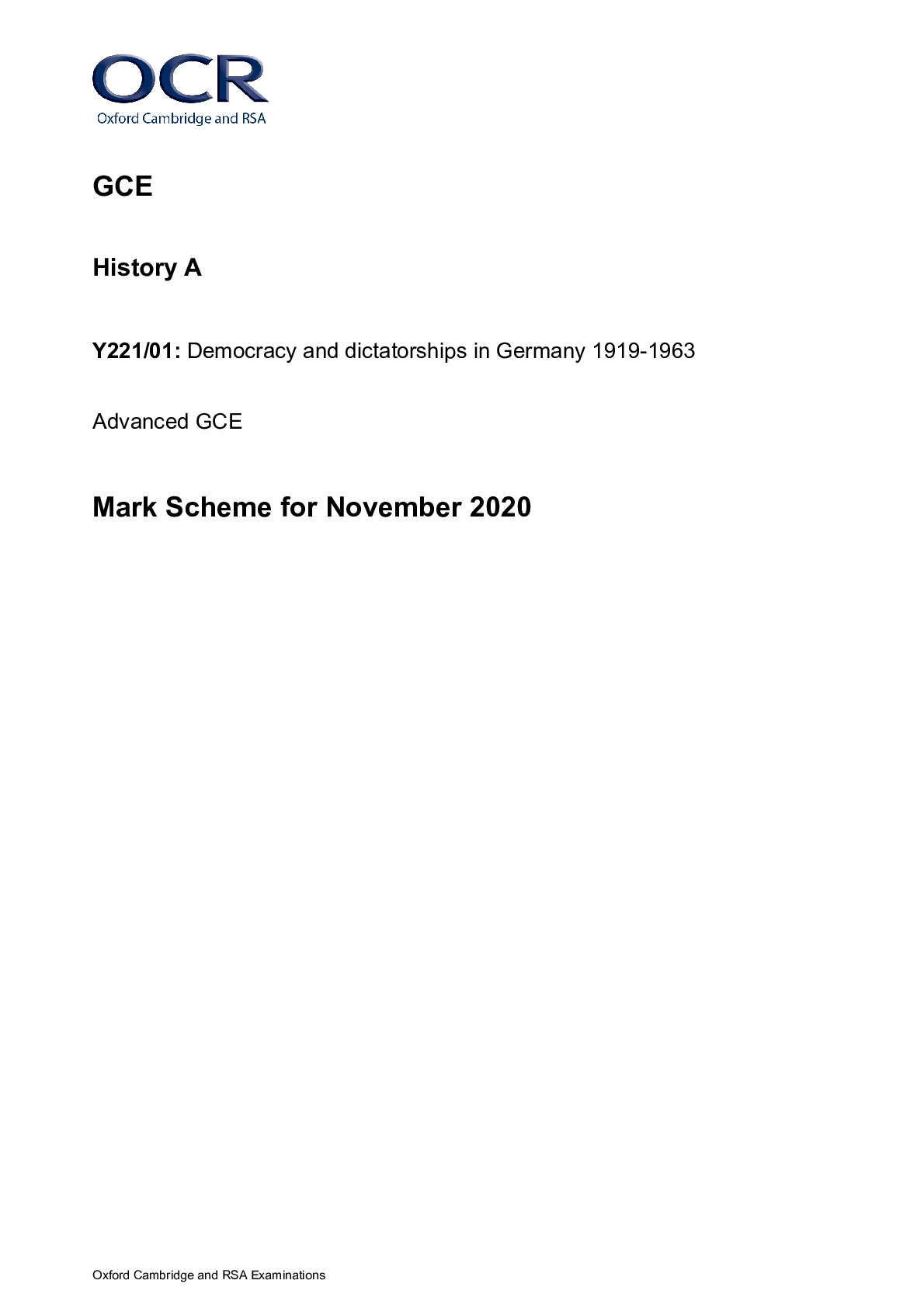

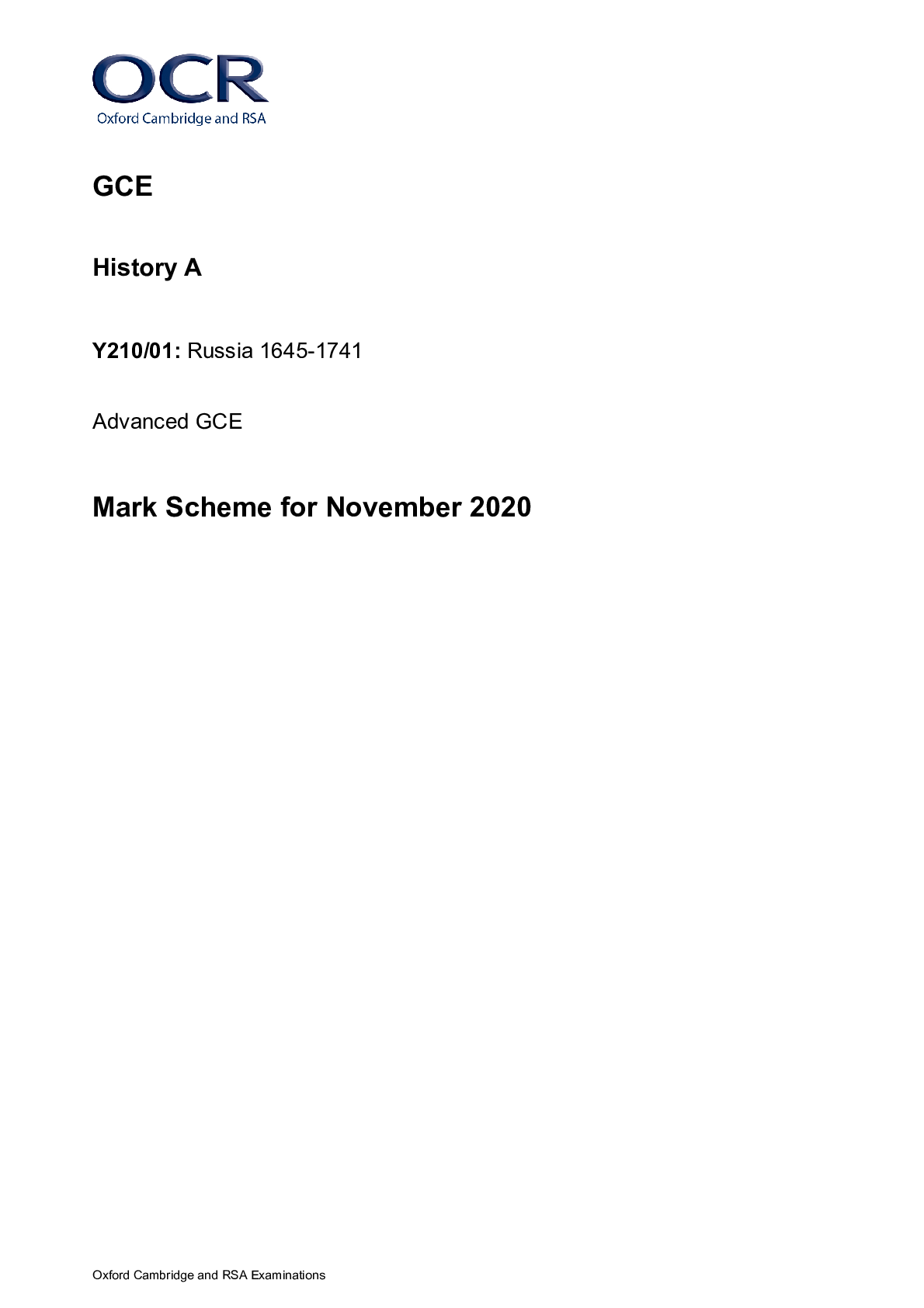


.png)



